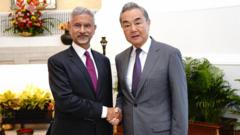Adidas has made headlines as it confirmed a decision to raise prices for American consumers due to the anticipated €200 million (£173 million) increase in costs from US tariffs. Chief Executive Bjorn Gulden indicated that nearly half of Adidas's products originate from Asian manufacturing countries, particularly Vietnam and Indonesia, which have recently entered trade agreements with the US. The implications of these tariffs raise questions about the potential impact on consumer purchasing behavior in response to inflationary pressures.
The recent tariffs, as part of broader trade agreements, include a 20% tariff on goods imported from Vietnam and a 19% tariff on products from Indonesia. US companies importing Adidas products will bear the brunt of these additional costs, which inevitably create a ripple effect leading to adjustments in retail pricing for American customers. Adidas, known for iconic footwear such as the Gazelle and Samba trainers, has indicated that manufacturing most of its products domestically in the US is not feasible.
The news comes amidst a competitive landscape where rival Nike has also announced price hikes for their training products, gearing up for potential cost increases related to tariffs that could reach around $1 billion (£730 million). Despite these challenges, Adidas managed to report a 7.3% increase in sales during the first half of the year, achieving €12.1 billion in revenue while experiencing a notable increase in pre-tax profit from €549 million to €1 billion.
Adidas's footwear sales exhibited a 9% increase in the second quarter, while clothing sales rose by 17%. However, with the uncertainty surrounding customer demand being underscored by these tariffs, it remains to be seen how consumers will respond as prices are adjusted.
The broader context of US tariffs under the previous Trump administration was aimed at tightening trade relationships and promoting domestic production. Recent agreements, including a deal with the EU to impose 15% tariffs on imports, raise concerns among German officials about the potential ramifications on both US and German economies.
Amid various sectors, the automotive industry has also been vocal regarding the toll that tariffs have taken on profitability, with companies like Mercedes-Benz and Porsche reporting considerable financial strain and subsequent price increases to offset higher import taxes. The cascading effect of tariffs continues to pose significant challenges to numerous industries, leaving many to contemplate the prolonged impact on both pricing structures and consumer habits across the globe.
The recent tariffs, as part of broader trade agreements, include a 20% tariff on goods imported from Vietnam and a 19% tariff on products from Indonesia. US companies importing Adidas products will bear the brunt of these additional costs, which inevitably create a ripple effect leading to adjustments in retail pricing for American customers. Adidas, known for iconic footwear such as the Gazelle and Samba trainers, has indicated that manufacturing most of its products domestically in the US is not feasible.
The news comes amidst a competitive landscape where rival Nike has also announced price hikes for their training products, gearing up for potential cost increases related to tariffs that could reach around $1 billion (£730 million). Despite these challenges, Adidas managed to report a 7.3% increase in sales during the first half of the year, achieving €12.1 billion in revenue while experiencing a notable increase in pre-tax profit from €549 million to €1 billion.
Adidas's footwear sales exhibited a 9% increase in the second quarter, while clothing sales rose by 17%. However, with the uncertainty surrounding customer demand being underscored by these tariffs, it remains to be seen how consumers will respond as prices are adjusted.
The broader context of US tariffs under the previous Trump administration was aimed at tightening trade relationships and promoting domestic production. Recent agreements, including a deal with the EU to impose 15% tariffs on imports, raise concerns among German officials about the potential ramifications on both US and German economies.
Amid various sectors, the automotive industry has also been vocal regarding the toll that tariffs have taken on profitability, with companies like Mercedes-Benz and Porsche reporting considerable financial strain and subsequent price increases to offset higher import taxes. The cascading effect of tariffs continues to pose significant challenges to numerous industries, leaving many to contemplate the prolonged impact on both pricing structures and consumer habits across the globe.


















